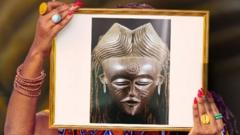Rohit Bal, a pioneering figure in Indian fashion who played a crucial role in popularizing the profession, has died at the age of 63 after a protracted illness. His passing was announced by the Fashion Design Council of India (FDCI), which lauded his contributions to the field, stating that his work "redefined Indian fashion".
Rohit Bal, Iconic Indian Fashion Designer, Passes Away at 63

Rohit Bal, Iconic Indian Fashion Designer, Passes Away at 63
Renowned for his innovative approach to Indian textiles, Bal leaves behind a legacy that reshaped the fashion landscape in India.
Bal’s celebrated career began in the vibrant 1990s, a time when he was one of the first designers to elevate fashion design into a glamorous career path in India. Many contemporary designers credit Bal as a significant influence in their own careers. Despite facing health challenges that forced him to step back from the spotlight, Bal made an emotional return to the industry only weeks before his death by taking part in the grand finale of India Fashion Week, displaying the same classic elegance that made him iconic.
Born in 1961 in Srinagar, Kashmir, Bal pursued his education at St. Stephen's College in Delhi before studying fashion design at the National Institute of Fashion Technology (NIFT). In 1990, he launched his eponymous label, quickly gaining a reputation for his extraordinary understanding of textiles and artistic attention to detail. His designs captivated not only Indian audiences but also international stars like Uma Thurman and Naomi Campbell, making him a household name in fashion.
His work often celebrated India's rich cultural heritage by incorporating traditional motifs like the lotus and peacock alongside luxurious fabrics such as velvet and brocade. Bal ventured beyond clothing design to endorse various products, enter the children’s fashion market, and even tackle costume design for prominent television shows and airlines, showcasing his versatility and creativity.
In addition to his fashion pursuits, he also made his mark in the culinary world, designing lavish interiors for restaurants, further demonstrating his broad artistic range. Throughout his life, Bal maintained a complex persona, often described in the media as flamboyant or "the bad boy of fashion". Yet, he frequently expressed a passion for Indian textiles and cultural artistry, believing that true fashion could not simply be replicated by foreign brands.
Rohit Bal leaves behind an indelible mark on Indian fashion and continues to inspire future generations. His contributions reveal an enduring commitment to artistry, culture, and the transformative power of fashion.
Born in 1961 in Srinagar, Kashmir, Bal pursued his education at St. Stephen's College in Delhi before studying fashion design at the National Institute of Fashion Technology (NIFT). In 1990, he launched his eponymous label, quickly gaining a reputation for his extraordinary understanding of textiles and artistic attention to detail. His designs captivated not only Indian audiences but also international stars like Uma Thurman and Naomi Campbell, making him a household name in fashion.
His work often celebrated India's rich cultural heritage by incorporating traditional motifs like the lotus and peacock alongside luxurious fabrics such as velvet and brocade. Bal ventured beyond clothing design to endorse various products, enter the children’s fashion market, and even tackle costume design for prominent television shows and airlines, showcasing his versatility and creativity.
In addition to his fashion pursuits, he also made his mark in the culinary world, designing lavish interiors for restaurants, further demonstrating his broad artistic range. Throughout his life, Bal maintained a complex persona, often described in the media as flamboyant or "the bad boy of fashion". Yet, he frequently expressed a passion for Indian textiles and cultural artistry, believing that true fashion could not simply be replicated by foreign brands.
Rohit Bal leaves behind an indelible mark on Indian fashion and continues to inspire future generations. His contributions reveal an enduring commitment to artistry, culture, and the transformative power of fashion.






















